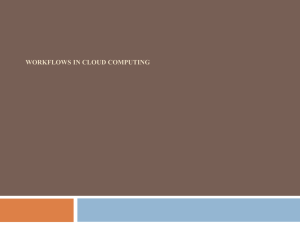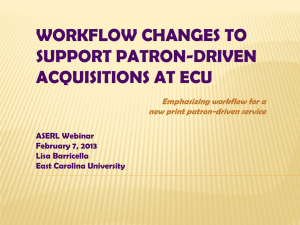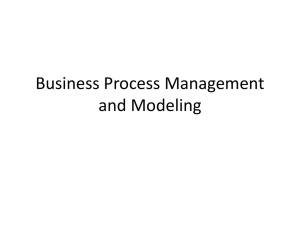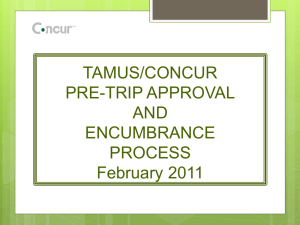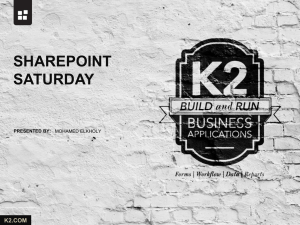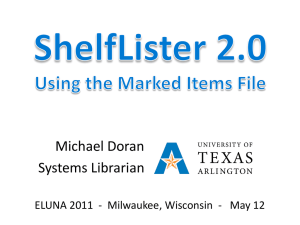Navigating the Workflows of Shelf-Ready, Embedded Order
advertisement
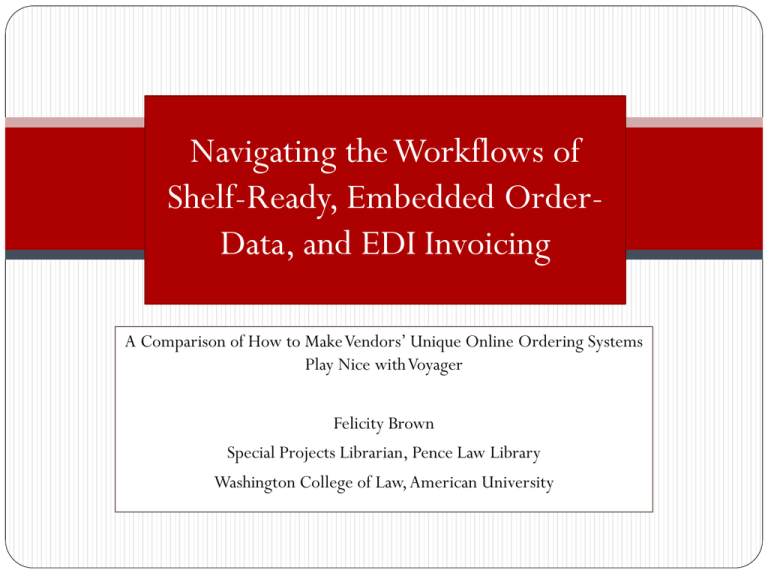
Navigating the Workflows of Shelf-Ready, Embedded OrderData, and EDI Invoicing A Comparison of How to Make Vendors’ Unique Online Ordering Systems Play Nice with Voyager Felicity Brown Special Projects Librarian, Pence Law Library Washington College of Law, American University Acquisitions at American University A Brief Summary Acquisitions Structure Washington Research Library Consortium Acquisitions Librarian Acquisitions Budgeting Coordinator Acquisitions Searcher Acquisitions Receiving Coordinator Acquisitions Searcher Receiving Specialist Processing/Print Serials Specialist Transitioning of Vendors Blackwell North America Was AU’s primary vendor (both approval plan, firms) Had started shelf-ready with just our approval plan Was bought out by Yankee Book Peddler Coutts Was AU’s secondary vendor Became AU’s primary vendor (took over our approval plan) in 2010 Set up shelf-ready/EOD/EDI Yankee Book Peddler (YBP) Currently AU’s secondary vendor Started process of setting up shelf-ready/EOD/EDI in 2011 Standardize Whenever Possible An Opportunity to Clean Up Your Voyager Database Do we really need all these codes? Obsolete codes Do the current fund codes meet the current need of the collection? Location codes: does this collection even still exist? Ask around Just because you have never used a fund or location code, doesn’t mean someone else isn’t using it Figure out what codes need special rules assigned Does this fund code get assigned to multiple location codes? Do those locations require spine-label prefixes, because they’re shelved outside the regular stacks? In our case: Curriculum Materials Center (CMC) Reference and Ready Reference Music Library Fund and Location Codes Bulk Import Profiles Standardize the naming schemes of your bulk import profiles for Voyager. This will: Make them easier to recognize Create templates for similar processes later Figure out where you could possibly use the same profile for different actions. Example: File overlays tend to be very similar Are they actually the same? Can we eliminate the need to create another profile Bulk Import Profiles Created in Voyager Web Admin Documentation Who does what? Streamline your workflow to keep similar tasks with the same staff person Make sure a second person is trained as a backup for every task, to provide coverage during an absence Make sure you map out “who does what when” clearly Keep a separate chart for each vendor Look for ways you could consolidate (ex. Do you really need every notification email?) Make sure to keep this information up to date. Document each workflow No matter how tedious, document each workflow as specifically as possible preferably with screenshots (to address different learning styles) Some example titles of documentation: Using Coutts Oasis with Embedded Order Data (EOD) YBP EDI Firm Order/Shelf Ready Receiving Workflow What to do if a Purchase Order imported in toVoyager is missing line items Get someone else to test your documentation Preferably not your most tech-savvy colleague If there are holes in your documentation, they’ll ask you questions. Go back and patch the holes. An Example of a Workflow Documented in Detail The following is a workflow developed to work around an issue we were having importing records with diacritical marks and/or long table of contents through the Voyager Web Admin using bulk import profiles. Check List Once you’re more comfortable with the workflow, it doesn’t hurt to have a cheat sheet Make a short check list of the steps of the workflow. For example, the workflow above would look like: Compare # of invoice lines to # records imported through Voyager Web Admin Identify any missing titles Find them using MarcEdit and fix them Create individual records for missing titles and save them to desktop Import through Cataloging module Add line item to invoice Communicating with Vendors • Email trails • Good for keeping promises on deliverables because they’re in writing and date stamped. • Phone calls • Be sure to summarize your “to do” lists at the end of the call, and write them down, with agreed deadlines • Site visits • WebEx • Screenshots • Video • What is their workflow? Who should you submit questions and requests to? • Who is the expert in what? (Sometimes hard to determine just from Department and Title) • Who actually get things done, and in a timely manner? (Identify your experts) Keep a quick reference guide handy Coutts YBP Get x document to Outstanding issue 1 [person] by [date] What’s the status of Issue y? Ask about z for [other staff member] Meet with collection managers re: use of notes field Outstanding issue 2 emailed so-and-so on [date]….promised response by [later date] New issue Is this feasible? What do we need to do to start the process? Sometimes phone and email just aren’t good enough When trying to explain complex problems to a vendor, screenshots are extremely helpful. When all else fails, try video. In a Perfect World… Vendors would come up with a ticketing system for requests, that shows: • When the task was requested • Who has claimed the task as something they’re working on • What the status of the request is…how far have they gotten on it, and what’s the next step in the process This system could be web based, or send email alerts when there is a status change. The more customers who ask…the more likely it is to happen. Asking for Enhancements The “White Card” Issue Do not be afraid to ask for enhancements The vendors work for you By requesting enhancements, you’re giving them a chance to improve their product and their marketability Do not be afraid to tell them what their competition is doing for you (or not doing for you) If you don’t ask for improvements, you’re just going to frustrate yourself in the long run Felicity Brown Special Projects Librarian, Pence Law Library Washington College of Law, American University fbrown@wcl.american.edu




